This was published 1 year ago
The ‘new Tinder’ – or something more? Why run clubs are gaining pace
A great way to keep fit and make friends. A panacea for loneliness. A modern-day church. And fun, so fun. No wonder run clubs have exploded post-pandemic.
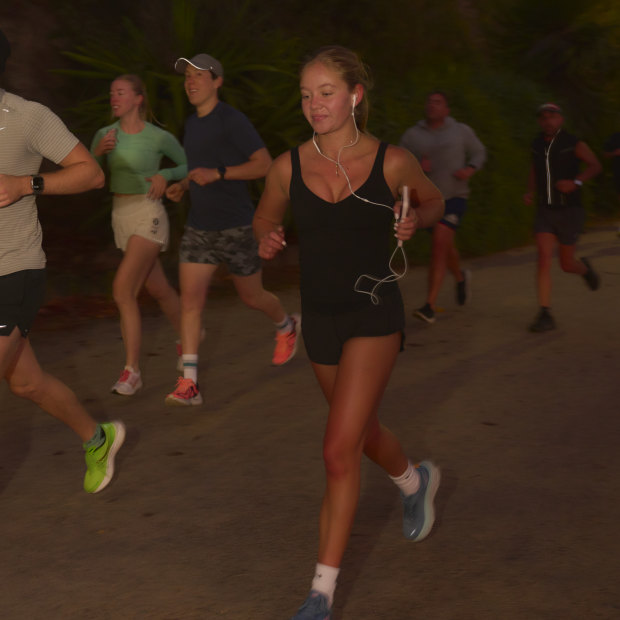
The number of Australians participating in recreational running leapt during the pandemic, surging from 3.4 million in 2019 to 4.2 million by the end of 2020.Credit: Josh Robenstone
It’s dark in predawn South Yarra, yet the footpaths are filling with tanned and toned types wearing Lycra and mesh. The amateur athletes converge quietly, like streams of water, pooling at the famous 3.8-kilometre Tan Track around Melbourne’s Royal Botanical Gardens.
It’s 5.37am on a Saturday – a moment infinitely better spent sleeping, or at least hitting the snooze button – but these folks have come for the opposite of sloth. They’re here to run, shuffle or walk – en masse – in a group that numbers comfortably more than 300 sporty souls.
And I’ve come to join them – sleep gunk stuck to the corners of my eyes – in the name of “research”, to better understand the burgeoning world of free amateur run clubs, which are popping up anew in cities, suburbs and towns around the world. It’s a modern movement driven by a confluence of factors, from gym closures during pandemic lockdowns to the growing loneliness epidemic, plus our renewed desire for authentic connection with community – not to mention mother nature – all supercharged by slick social media promotion.
This particular group, Run South Yarra, is one of the more popular in Melbourne. Not to put anyone off joining their incredibly welcoming weekend dogtrot, but for a middle-aged overweight bloke like me, much of this cohort appears sickeningly fit and impossibly beautiful.
After a few dynamic stretches we’re off, for one lap, or two, or three – at whatever pace you like – and I feel staggeringly sluggish. It’s as though I’m
surrounded by ballet dancers pitter-pattering past en pointe in Lululemon and Nike ZoomX Vaporflys, while my 115-kilogram frame thumps along the gravel course like Shrek. I’m the hippo passed by herds of glossy-coated
gazelles, the rusty diesel truck amid a fleet of new Teslas. You get the idea.
‘They’re on that runner’s high, they’re open for a chat. It drops the barriers.’
Cameron Macdonald, Run South Yarra co-founder
And I’m sure Run South Yarra co-founders Tom Adair and Cameron Macdonald do, too, as I sit down –sweaty and stinking and spent – for coffee with them immediately afterwards. It’s not yet 7am and their amateur run club has completely overtaken the luxe cafes along Domain Road, because friendly connection over a post-run skinny latte is the highlight – perhaps the whole point – of this run club and others.
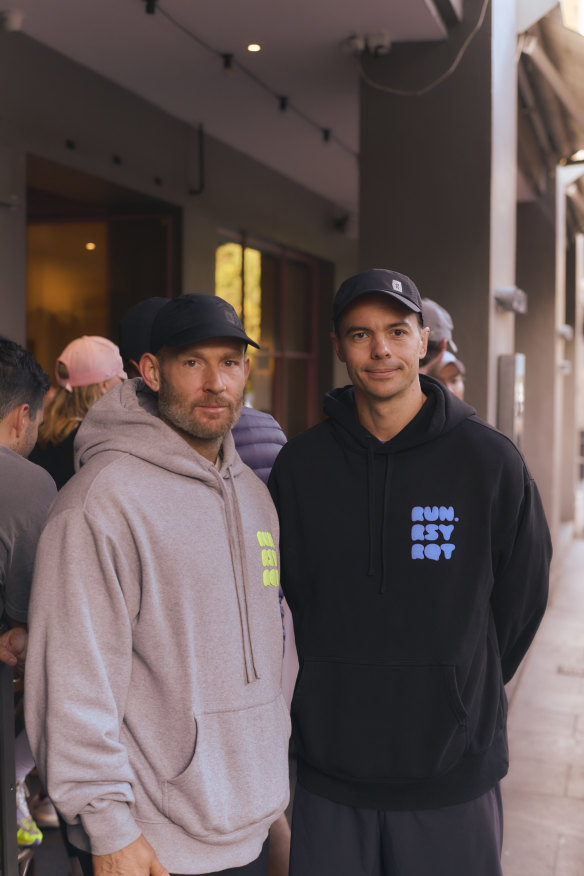
Run South Yarra co-founders Tom Adair (left) and Cameron Macdonald started the club in 2022 with an Instagram post.Credit: Josh Robenstone
Just ask the members of SoSo’s Run Club in Brisbane, named not only for its founders – Sophie (Rindfleish) and Sofie (Spelta) – but because they welcome everyone from speed demons to “so so” runners to come on down for a coffee and a weekly Sunday 6am waterfront jaunt. In NSW, there’s the famous 440 Run Club, which began as a way for great mates Todd Liubinskas and Trent Knox to help each other deal with deep personal demons – by charging up and down a 440-metre hill at Bronte Beach at sunrise – while at the opposite end of the spectrum there are casual communal jogs like the Croissant Run Club and the Pastry Yourself Run Club, which end at popular Sydney bakeries.
“Everyone who comes down for a run, they find afterwards that they’re on that runner’s high, they’re open for a chat. It drops the barriers,” says Macdonald, a 35-year-old landscape architect, sipping his iced long black. “The conversation just kicks off because you’ve got that common ground to connect.”
Macdonald and Adair, a 41-year-old artist, have been gym buddies for years but started the club in 2022 with an Instagram post. “It was really basic – a map with a drop pin, ‘Meet here 6am tomorrow’ – and maybe five people came, just good friends,” says Macdonald. “Early morning group runs weren’t such a big thing at the time, so people liked the novelty.”
They started in winter, which was a grind, but did it again the following week and the week after. Within a few months, 30 people were coming along, then 40, then 50. When summer arrived, their ranks swelled to 100. The group now hosts a long run on Sundays and a midweek track speed session with whistles and cones.
It’s become a somewhat serious endeavour for its organisers. They sell branded sweatshirts, while the athletics apparel company On asked to work with them documenting an ultramarathon relay they joined recently in California. They’ve been posting on socials with regular reels and stories, and when one of their crew joined TikTok, they suddenly had a whole new audience.
As an organising tool, says University of Melbourne associate professor and social media expert Lauren Rosewarne, social media makes coordination of any group gathering more effective and more efficient. Take protests, she says. In the analogue world, activism was built on an ad hoc basis through laborious mailing lists and phone trees. This new ease of digital connection reminds Rosewarne of something else.
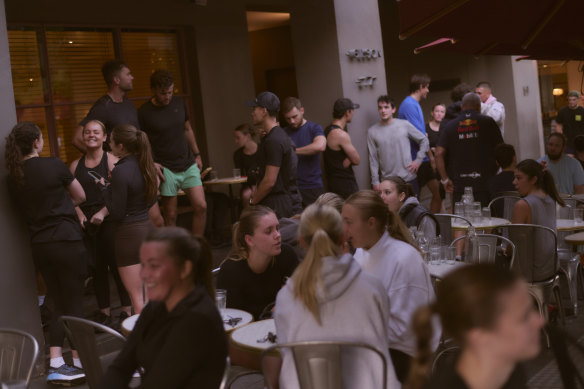
For Run South Yarra club members, the post-run socialising over a latte is a highlight.Credit: Josh Robenstone
“The first thing that comes to mind is … sex stuff,” she says. “However obscure you might find your sexual interests, the internet will help you find that shared kink. Run clubs become this tame way of finding people with a shared characteristic. It’s not like writing ‘I like bushwalking’ on your online profile in some abstract sense. It’s real.”
Run South Yarra co-founder Tom Adair is wary of any suggestion that run clubs are the new Tinder, yet relationships are born here, and side-by-side chats while jogging, he notes, are definitely less pressurised than face-to-face interactions. (Plus, you can always pick up the pace and scoot away if a chat isn’t going well.) “It’s almost like a nightclub, but no one’s drunk, and you’re actually making meaningful conversation,” Adair concedes. “We’ve been hit up by dating apps to partner with them, but we’ve turned them away because it takes away from what we actually do. We’re in this for the long haul, rather than a fad.”
It’s worth noting here that run clubs are nothing new. I joined my first one two decades ago, when I was living in the Adirondacks, a US region of high peaks and deep lakes near the Canadian border. I was training for the New York City Marathon and writing a weekly column about it for the local newspaper. My first piece began: Running is a lonely sport …
The endorphin rush, weight loss and smug self-satisfaction were great, I reasoned in print, but running through snow and sleet and slush – or slipping on black ice – was grim. The primary experience was “being alone with my frigid pain” until returning home exhausted and hypothermic, with frozen snoticles dangling from my moustache.
That’s when a reader contacted me. She was part of a team of local runners who met for sessions at one another’s homes, including a regular “breakfast run”. Joggers would pair up according to speed and distance, then cruise through that wintry panorama together. I decided to join, and when we got back from an early run we’d eat all the eggs, bacon, bagels and coffee that the pool contributed. At every stage of my marathon training – when starting out, and struggling to get through 10 kilometres, and nearing the end, when I needed company on a three-hour run – I could lean on their expertise and encouragement. I came to see that running wasn’t just for loners, but communal in essence.
It wasn’t the only time. While working in Indianapolis, I joined a local “hashers” club – basically a group of grown-ups playing an endurance game of hide and seek … with beer. A “hare” lays a course with flour and chalk, and the “hounds” all chase it. (Booze is often left on the trail to slow the hounds down.) There are hashing groups all over the world – including in Australia –bringing a bawdy flavour to running. They favour nicknames and chants and silly songs, and, as I discovered in the woods in Indiana one day, occasionally even a weird rite of passage that invites (not dictates) female hashers to flash their breasts. They’re an irreverent worldwide society with a motto to match: “We’re drinkers with a running problem.”
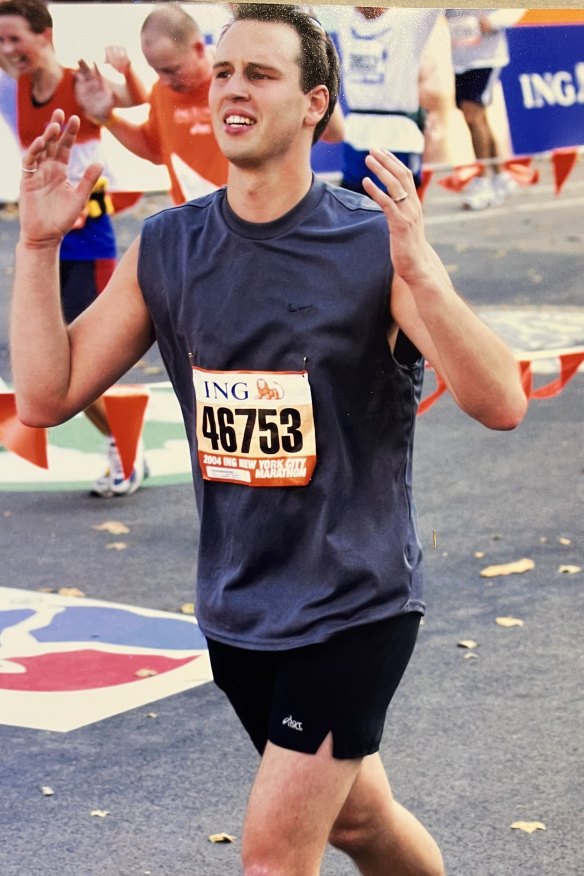
Author Konrad Marshall running the New York City Marathon in 2004.
I ran with yet another group while writing for a newspaper in Florida, as part of my training for Jacksonville’s annual Gate River Run. It was a group I formed myself, in fact. A few other reporters from the local paper would meet in the late afternoon, when the weather reliably turned tropically wet, and we would run in the humidity and then grab a Southern barbecue for dinner. That invitation had a gravitational effect, drawing a committed cadre together – joining for the shared mileage and staying for the pulled pork.
The common thread here – whether in America’s North-East or Midwest or Deep South – is that I was a stranger in a strange land, moving from one place to another for work, and looking not so much for a way to get fit as a way to find friends. And that’s a need still strongly served by run clubs, perhaps more than ever before, following not just the social dislocation of the pandemic but the slow, steady creep of solitary living.
Dr Marlee Bower of the Matilda Centre for mental health research at the University of Sydney co-convened a workshop in the United Kingdom last year titled “Where the hell do you meet new people?” and notes that shared hobbies such as running create a pivotal sense of purpose and perspective – an important safety net if or when our lives shift abruptly due to circumstance. “If you lose one identity – retiring from your career, for instance, or through the breakup of a marriage – it’s important to have other identities to fall back on, as a father maybe, or a volunteer,” she says. “Or a runner.”
There is good reason to exercise caution, however, and temper enthusiasm for pace-based socialising. Firstly, running might seem a universally accessible pastime, but finding the free time and transport to join a group jog – meeting at a set hour and location – is a luxury for many. And, says Bower, for those hoping to find their tribe but also fearful of rejection, “there’s also a potential dark side to this. If things don’t go well when people join up, it can make their mental health and loneliness even worse.”
But on the whole, she says, these groups fill a space previously occupied by church. The parallels are striking, from the religious fervour among the true believers (and converts) to the weekly commune and effort required to bring your best self. “What else is there for that?” Bower asks. “We need those places where people can go to belong in a post-pandemic world.”
Many of us are still withdrawing from big social gatherings – or perhaps reporting a “social hangover” after one too many events in succession – and in large sections of the workforce, self-isolating flexible work arrangements are here to stay. “We haven’t created new rules of engagement,” says Bower. “We’re still in this hybrid space. And these new groups can forge a way of getting closer together again, on our own terms.”
‘If you want to go at the speed of light, you do that. And if you want to chill out, that’s fine too. You do you.’
Jared Tower, Melbourne Frontrunners
That’s incredibly important to the group I join on a gorgeous autumn evening near the Shrine of Remembrance in Melbourne. I’m here with about three dozen people – the mostly male members of Melbourne Frontrunners, a run club for the LGBTQI+ community – and this Wednesday night is their more serious weekly training session. Running the show is physiotherapist Jared Tower, 34, who is putting us through our warm-up activations – little runs with the knees up or heels back – before a series of high-intensity loops through the Queen Victoria Gardens on St Kilda Road. Tower sometimes calls like a drill sergeant – “Go HARD! Now go EASY!” – and other times, such as when a handful of guys are talking too loudly, he becomes a schoolteacher: “Please girls, quiet!”
The initial allure for Tower was joining a like-minded group who run at different days and times to suit his hospital shift work. Initially worried that he wouldn’t be fast enough, seven years later he runs marathons in under three and a half hours. Not that running quickly matters. “If you want to go at the speed of light, you do that. And if you want to chill out, that’s fine too,” he says. “You do you, boo.”
Tower hands out lolly snakes as the runners tear around the out-and-back course he’s set, and when they finish, everyone gets a frosty Zooper Dooper. Before they head off to their ritualistic post-session dinner and drinks at the Arcadia Hotel on Toorak Road, a few of the boys explain how their bunch has become “critical social infrastructure” and a “third space for our community”.
Celebrating their 20th anniversary, this group of 340 members used to hold an AGM but now have an annual gala instead – a midwinter ball with dancing and awards. “Bars are there, clubs are there, and apps are there, but it’s nice to have a variety of things that LGBTQI+ people can be a part of, based on their interests,” Tower says. “It’s really purposeful. It’s something I get up for and go to every week. And I think that’s really lovely.”
There’s seemingly a specific run club for everyone. Medical administrator Madeline Seiter, 30, is president of the Melbourne chapter of Achilles Australia, which hosts run clubs for the disabled. Seiter is blind and had never really run – in fact hated the idea of running – when she joined in 2017. She started out as a walker, and now runs with a volunteer guide, connected by a tether held in her hand. (Other runners use hip tethers tied to the waist.) “One of the hardest things for disabled people to do with new activities is get yourself out the door and get there,” she says. “It was quite daunting.”
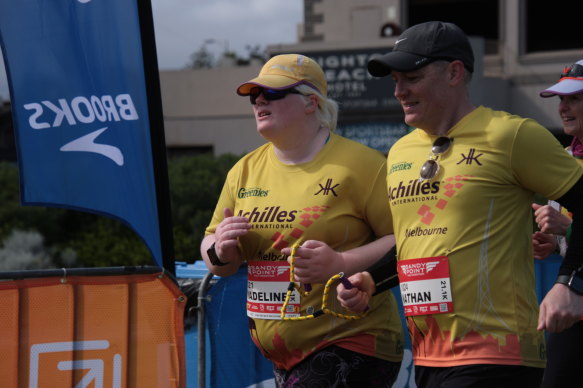
Achilles Melbourne hosts run clubs for the disabled.
Many disabled people are taught that running is unsafe for them, so they often need to learn how to run, including basic actions like lifting their feet instead of seeking the security of the ground through constant shuffling. Seiter’s gone from a shuffle to a stroll to a sprint and beyond. She cycles now – on a tandem bike – and tethered swimming is taking off in her life as well; she was the first blind tethered swimmer to compete in the Pier to Pub in Lorne on the Great Ocean Road. Last year she completed the New York City Marathon. It took 7 hours and 59 minutes.
“It was hard. Really hard. But the biggest shock to me was the atmosphere – on both sides of the road there were people 10 deep, yelling and making noise,” she says. (Those crowds were a highlight when I ran the same race in 2004, but Seiter’s perspective is a little different.) “It was actually one of the biggest hurdles. I wasn’t expecting that much noise and commotion.”
Finding the right run club is often about finding your tribe. Record label manager Brit de Groot, 33, founded her own running club two years ago after feeling too slow elsewhere. “I don’t know if you’ve ever experienced being at the back of a social run, and you’re completely gassed, red-faced and can’t talk,” – definitely – “but it’s not nice. It was a feeling I didn’t like and wanted to avoid. I think there’s a cool factor that can be intimidating with some run crews, so it was about making a safe space for people to be themselves.”
The Flow State run club – for women only – was born, and now 15 to 20 of their 50-odd members show up every Wednesday night at 6pm for a run around Melbourne’s Albert Park and a beer afterwards. Many of them just come down for the beer, while others seek the security of running together. And who can blame them, following the disappearance of Ballarat mum Samantha Murphy, who went missing in February while on a 14-kilometre run during broad daylight?
“All the females that run with us have experienced some level of not feeling safe, whether it’s a cat call, or someone following them in a car, someone saying something gross to you. It’s either condescending or sexualised, and it’s just f---ing shit,” de Groot says. “I’d love to go for a run at 10pm at night, but I know I can’t. Whereas there’s never a door closed for a male runner.”
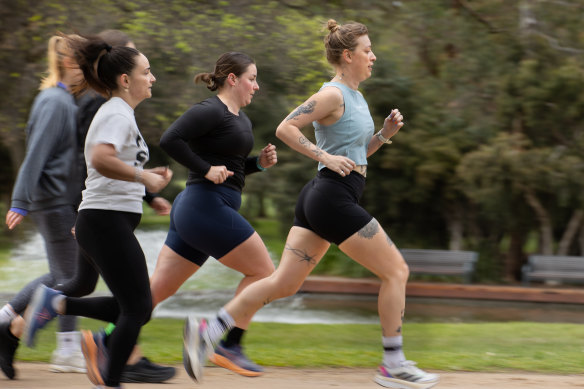
Flow State run club is for women only. Organiser Brit de Groot wanted to avoid the “cool factor” of some clubs.Credit: Simon Schluter
Her own running habit started during pandemic lockdowns, searching for a meditative calm and mental health break in a natural setting. “It’s just great to get out and have some quiet time,” she says. “You find these little pockets of green space, like my favourite wetlands near Brunswick. You take the headphones out, eyes up, connecting to what’s around you.”
Many members report that one of the great running pleasures lies in utilising beautiful public green spaces, and indeed, the staggering rise of run clubs is perhaps no better illustrated than by the biggest player in the space: Parkrun. That free weekly global event – held in parks around the world every Saturday at 8am – began in 2004 with a single London event featuring 13 runners and five volunteers. It has spread to 20 countries, and the average number of walkers, runners and volunteers taking part every week is up to almost 370,000.
That includes 77,000 Australians (in almost 500 locations), a 22 per cent increase on 2023. “You would think that – having reached 1 million total Australian participants since 2011 – it would slow down, but in 13 years we’ve never seen growth like that before,” says Glen Turner of Parkrun Asia Pacific. “This is a huge spike, and I have to think the current cost of living is a factor.”
There aren’t many regular organised opportunities, he adds, where you can take your family – and your dog – to enjoy a free, inclusive mass recreation event. Every Parkrun has volunteer “park walkers” who simply stroll the course, to show everyone that walking is also celebrated, while another crucial volunteer is the “tail walker” who puts their hand up to finish last, so that no one feels that sting of embarrassment.
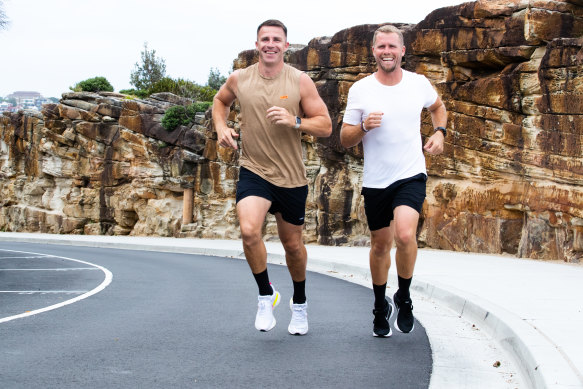
Friends Todd Liubinskas (left) and Trent Knox started the 440 Run Club in Bronte, Sydney, as a way of tackling personal demons.Credit: Edwina Pickles
All these clubs are benefiting from a more general global running renaissance, led by the resurgent popularity of everything from Diamond League racing in Europe to stunning superhuman feats like Eliud Kipchoge breaking two hours for the marathon, to the growing celebrity of Norwegian 1500-metre world champion (and reality TV star) Jakob Ingebrigtsen, who even has his own Amazon Prime special in the works. Only last month, Pearl Jam announced the formation of the band’s own run club (#PearlJamRunningClub), calling on fans to go for a jog while listening to a curated Spotify playlist, then post screenshots of run routes in shapes inspired by their new album Dark Matter.
This surge in cachet has been pleasantly surprising for Australia’s premier distance running coach, Nic Bideau. Supervising a recent Tuesday morning training session for 50 elite runners at a track in Melbourne’s Glen Waverley, Bideau cast his mind back. “Years ago, when I saw someone else out on the street running, I knew they were either a serious athlete or a league footballer,” he says. “Now, I drive to training on a Saturday morning and I pass about a thousand people – thousands of ordinary people.”
In reality, there are millions of us. AusPlay participation data suggests the number of Australians participating in recreational running leapt during the pandemic lockdowns, surging from 3.4 million in 2019 to 4.2 million by the end of 2020. As a crude recent measure, take last year’s Melbourne Marathon, where every event – the full marathon (9500 runners), half-marathon (12,000), 10-kilometre race (11,000) and five-kilometre race (5000) – sold out months in advance, then drew a waiting list more than 17,000 entrants long.
“It’s amazing,” Bideau says, as he watches national champions and Olympians like Stewart McSweyn and Brett Robinson go through their paces. “For these sorts of guys here, they’re suddenly not dorks or nerds any more for training all the time. Running’s cool again.”
To read more from Good Weekend magazine, visit our page at The Sydney Morning Herald, The Age and Brisbane Times.